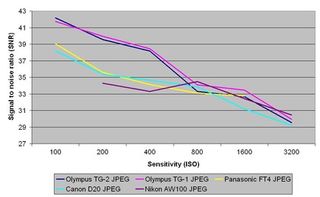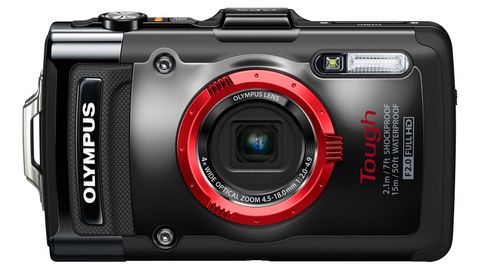Why you can trust TechRadar
We shoot a specially designed chart in carefully controlled conditions and the resulting images are analysed using DXO Analyzer software to generate the data to produce the graphs below.
A high signal to noise ratio (SNR) indicates a cleaner and better quality image.
For more more details on how to interpret our test data, check out our full explanation of our noise and dynamic range tests.
Here we compare the Olympus TG-2 with the Canon D20, Olympus TG-1, Nikon AW100 and Panasonic FT4.
JPEG signal to noise ratio

These results show that images from the Olympus TG-2 have a signal to noise ratio very similar to those from the Olympus TG-1, though ever so slightly weaker at most sensitivities. The Olympus TG-2's photos have a better ratio than pictures from the Canon D20, Nikon AW100 and Panasonic FT4 at ISO 100-800, but they are weaker than the Nikon's at ISO 800 and 3200 and they're weaker than the Canon's at ISO 800.
A strong signal to noise ratio normally means that a camera produces cleaner images than its competitors, often with more detail. However, as appears to be the case here, the camera may be better at masking the noise as our tests show the TG-2 does not out-resolve its competition.
JPEG dynamic range

The Olympus TG-2's JPEG photos show the weakest dynamic range of the group at ISO 100 and 200, before improving enough to beat those from the Olympus TG-1 at ISO 400 and above. At ISO 400 the Olympus TG-2's images contain the same dynamic range as those from the Nikon AW100 and Panasonic FT4, and at ISO 1600 the TG-2's meet the Panasonic's again. At every other sensitivity setting the TG-2's JPEGs contain less dynamic range than the Nikon and Panasonic's. The TG-2's pictures contain less dynamic range than the Canon D20's at every sensitivity.
A low dynamic range indicates that images will not contain a wide range of tones, however, it can also mean that the camera produces quite punchy, high-contrast images.
Current page: Noise and dynamic range
Prev Page Image quality and resolution Next Page Sample images
